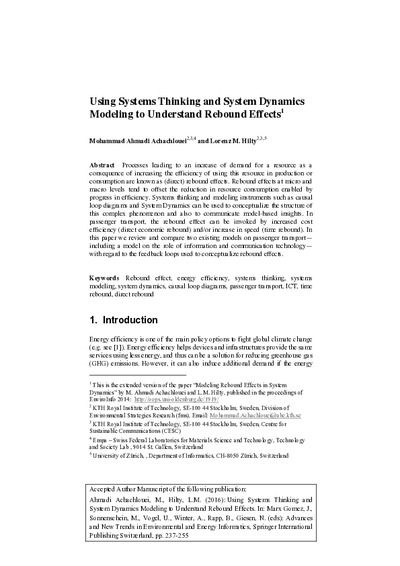Using Systems Thinking and System Dynamics Modeling to Understand Rebound EffectsMohammad Ahmadi Achachlouei, Lorenz M. Hilty
Publikationsdatum:
|
 |
 Diese Seite wurde seit 2 Jahren inhaltlich nicht mehr aktualisiert.
Unter Umständen ist sie nicht mehr aktuell.
Diese Seite wurde seit 2 Jahren inhaltlich nicht mehr aktualisiert.
Unter Umständen ist sie nicht mehr aktuell.
 Zusammenfassungen
Zusammenfassungen
In this paper, using the domain of passenger transport as an example, we review and compare two existing models on passenger transport (developed in the context of environmental impacts of transport), including a model on the effects of ICT on transport.
Von Mohammad Ahmadi Achachlouei, Lorenz M. Hilty im Text Using Systems Thinking and System Dynamics Modeling to Understand Rebound Effects (2016) Processes leading to an increase of demand for a resource as a consequence of increasing the efficiency of using this resource in production or consumption are known as (direct) rebound effects. Rebound effects at micro and macro levels tend to offset the reduction in resource consumption enabled by progress in efficiency. Systems thinking and modeling instruments such as causal loop diagrams and System Dynamics can be used to conceptualize the structure of this complex phenomenon and also to communicate model-based insights. In passenger transport, the rebound effect can be invoked by increased cost efficiency (direct economic rebound) and/or increase in speed (time rebound). In this paper we review and compare two existing models on passenger transport - including a model on the role of information and communication technology - with regard to the feedback loops used to conceptualize rebound effects
Von Mohammad Ahmadi Achachlouei, Lorenz M. Hilty im Text Using Systems Thinking and System Dynamics Modeling to Understand Rebound Effects (2016)  Bemerkungen
Bemerkungen
This is the extended version of the paper “Modeling Rebound Effects in System Dynamics" by M. Ahmadi Achachlouei and L.M. Hilty, published in the proceedings of EnviroInfo 2014: http://oops.uni-oldenburg.de/1919/
Von Mohammad Ahmadi Achachlouei, Lorenz M. Hilty im Text Using Systems Thinking and System Dynamics Modeling to Understand Rebound Effects (2016)  Dieser wissenschaftliche Zeitschriftenartikel erwähnt ...
Dieser wissenschaftliche Zeitschriftenartikel erwähnt ...
 Personen KB IB clear | Jay Forrester , John D. Sterman | |||||||||||||||||||||||||||
 Begriffe KB IB clear | Direkter Rebound-Effekt
, Efficiency (Usability-Dimension)Efficiency
, Indirekter Rebound-Effekt
,  Klimawandel
, Komplexitätcomplexity
, Klimawandel
, Komplexitätcomplexity
,  Modelle Modelle model
, model
,  rebound effect / Jevons' paradox
, Rückkopplung / Regelkreisfeedback loop
, Simulation
, Systemsystem
, system dynamicssystem dynamics
, rebound effect / Jevons' paradox
, Rückkopplung / Regelkreisfeedback loop
, Simulation
, Systemsystem
, system dynamicssystem dynamics
,  Systemarchetypen Systemarchetypen system archetypes
, Systemdenkensystems thinking system archetypes
, Systemdenkensystems thinking
| |||||||||||||||||||||||||||
 Bücher |
|
 Dieser wissenschaftliche Zeitschriftenartikel erwähnt vermutlich nicht ...
Dieser wissenschaftliche Zeitschriftenartikel erwähnt vermutlich nicht ... 
 Nicht erwähnte Begriffe | Escalation, Negative Rückkoppelung, Positive Rückkoppelung / Teufelskreis |
 Tagcloud
Tagcloud
 Zitationsgraph
Zitationsgraph
 Zitationsgraph (Beta-Test mit vis.js)
Zitationsgraph (Beta-Test mit vis.js)
 Volltext dieses Dokuments
Volltext dieses Dokuments
 |  Using Systems Thinking and System Dynamics Modeling to Understand Rebound Effects: Artikel als Volltext ( Using Systems Thinking and System Dynamics Modeling to Understand Rebound Effects: Artikel als Volltext ( : :  , 649 kByte; , 649 kByte;  : :  ) ) |
 Anderswo suchen
Anderswo suchen 
 Beat und dieser wissenschaftliche Zeitschriftenartikel
Beat und dieser wissenschaftliche Zeitschriftenartikel
Beat hat Dieser wissenschaftliche Zeitschriftenartikel während seiner Zeit am Institut für Medien und Schule (IMS) ins Biblionetz aufgenommen. Er hat Dieser wissenschaftliche Zeitschriftenartikel einmalig erfasst und bisher nicht mehr bearbeitet. Beat besitzt kein physisches, aber ein digitales Exemplar. Eine digitale Version ist auf dem Internet verfügbar (s.o.). Es gibt bisher nur wenige Objekte im Biblionetz, die dieses Werk zitieren.







 Biblionetz-History
Biblionetz-History